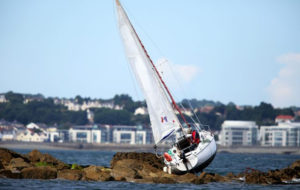 On our family’s maiden voyage in our restored vintage Thunderbird sailboat we found ourselves navigating the tidal narrows between two of the gulf islands in British Columbia. We were running with the tide at about 6 knots and under motor we pushed a little faster to maintain steerage. To our left emerged a picturesque and stunning little bay. “Let’s go in there, some one piped up.” A hard turn to port and in we went. The charts indicated there was a reef, but surely I was far enough away from shore to miss it? BANG. The T-Bird catapulted forwarded, I almost ended up on the cabin sole and thank God, no one went overboard. We hit the dreaded rock, bounced right over it, and kept going. Later, as I repaired the damage, I could see the mark on the fin Keel. All we needed was 4 more inches of clearance and we would have sailed unwittingly over the dangerous rock.
On our family’s maiden voyage in our restored vintage Thunderbird sailboat we found ourselves navigating the tidal narrows between two of the gulf islands in British Columbia. We were running with the tide at about 6 knots and under motor we pushed a little faster to maintain steerage. To our left emerged a picturesque and stunning little bay. “Let’s go in there, some one piped up.” A hard turn to port and in we went. The charts indicated there was a reef, but surely I was far enough away from shore to miss it? BANG. The T-Bird catapulted forwarded, I almost ended up on the cabin sole and thank God, no one went overboard. We hit the dreaded rock, bounced right over it, and kept going. Later, as I repaired the damage, I could see the mark on the fin Keel. All we needed was 4 more inches of clearance and we would have sailed unwittingly over the dangerous rock.
Navigation is tricky. You want to know what the dangers are, but you also have to know your position. Speed, tide, wind, depth, drift, are all factors, but the final decisions are up to the skipper.
In coaching you are the skipper. You are in control. However, it is helpful to receive input. What does the GPS say (we didn’t have one)? How fast are we travelling? What are the dangers? A competent skipper normally ingests the resources available, and comes to a logical, and hopefully safe decision.
Who is asking you the questions? Where are you going? What is your position? Where are the dangers? What will you do if something goes wrong? What does success look like?
Skippers who are in control want competent input!



No responses yet